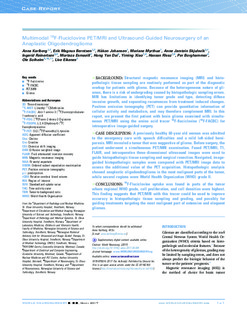| dc.contributor.author | Karlberg, Anna Maria | |
| dc.contributor.author | Berntsen, Erik Magnus | |
| dc.contributor.author | Johansen, Håkon | |
| dc.contributor.author | Myrthue, Mariane Olesen | |
| dc.contributor.author | Skjulsvik, Anne Jarstein | |
| dc.contributor.author | Reinertsen, Ingerid | |
| dc.contributor.author | Esmaeili, Morteza | |
| dc.contributor.author | Dai, Hong Yan | |
| dc.contributor.author | Xiao, Yiming | |
| dc.contributor.author | Rivaz, Hassan | |
| dc.contributor.author | Borghammer, Per | |
| dc.contributor.author | Solheim, Ole | |
| dc.contributor.author | Eikenes, Live | |
| dc.date.accessioned | 2017-11-09T08:12:09Z | |
| dc.date.available | 2017-11-09T08:12:09Z | |
| dc.date.created | 2017-11-08T11:33:48Z | |
| dc.date.issued | 2017 | |
| dc.identifier.issn | 1878-8750 | |
| dc.identifier.uri | http://hdl.handle.net/11250/2465088 | |
| dc.description.abstract | Background
Structural magnetic resonance imaging (MRI) and histopathologic tissue sampling are routinely performed as part of the diagnostic workup for patients with glioma. Because of the heterogeneous nature of gliomas, there is a risk of undergrading caused by histopathologic sampling errors. MRI has limitations in identifying tumor grade and type, detecting diffuse invasive growth, and separating recurrences from treatment induced changes. Positron emission tomography (PET) can provide quantitative information of cellular activity and metabolism, and may therefore complement MRI. In this report, we present the first patient with brain glioma examined with simultaneous PET/MRI using the amino acid tracer 18F-fluciclovine (18F-FACBC) for intraoperative image-guided surgery.
Case Description
A previously healthy 60-year old woman was admitted to the emergency care with speech difficulties and a mild left-sided hemiparesis. MRI revealed a tumor that was suggestive of glioma. Before surgery, the patient underwent a simultaneous PET/MRI examination. Fused PET/MRI, T1, FLAIR, and intraoperative three-dimensional ultrasound images were used to guide histopathologic tissue sampling and surgical resection. Navigated, image-guided histopathologic samples were compared with PET/MRI image data to assess the additional value of the PET acquisition. Histopathologic analysis showed anaplastic oligodendroglioma in the most malignant parts of the tumor, while several regions were World Health Organization (WHO) grade II.
Conclusions
18F-Fluciclovine uptake was found in parts of the tumor where regional WHO grade, cell proliferation, and cell densities were highest. This finding suggests that PET/MRI with this tracer could be used to improve accuracy in histopathologic tissue sampling and grading, and possibly for guiding treatments targeting the most malignant part of extensive and eloquent gliomas. | nb_NO |
| dc.language.iso | eng | nb_NO |
| dc.publisher | Elsevier | nb_NO |
| dc.rights | Attribution-NonCommercial-NoDerivatives 4.0 Internasjonal | * |
| dc.rights.uri | http://creativecommons.org/licenses/by-nc-nd/4.0/deed.no | * |
| dc.title | Multimodal 18F-Fluciclovine PET/MRI and Ultrasound-Guided Neurosurgery of an Anaplastic Oligodendroglioma | nb_NO |
| dc.type | Journal article | nb_NO |
| dc.type | Peer reviewed | nb_NO |
| dc.description.version | publishedVersion | nb_NO |
| dc.source.journal | World Neurosurgery | nb_NO |
| dc.identifier.doi | 10.1016/j.wneu.2017.08.085 | |
| dc.identifier.cristin | 1512166 | |
| dc.description.localcode | © 2017 The Author(s). Published by Elsevier Inc. This is an open access article under the CC BY-NC-ND license (http://creativecommons.org/licenses/by-nc-nd/4.0/). | nb_NO |
| cristin.unitcode | 194,65,25,0 | |
| cristin.unitcode | 194,65,15,0 | |
| cristin.unitcode | 194,65,30,0 | |
| cristin.unitname | Institutt for sirkulasjon og bildediagnostikk | |
| cristin.unitname | Institutt for klinisk og molekylær medisin | |
| cristin.unitname | Institutt for nevromedisin og bevegelsesvitenskap | |
| cristin.ispublished | true | |
| cristin.fulltext | original | |
| cristin.qualitycode | 1 | |

